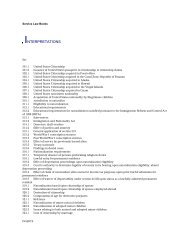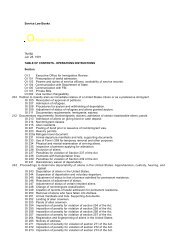You also want an ePaper? Increase the reach of your titles
YUMPU automatically turns print PDFs into web optimized ePapers that Google loves.
<strong>Inspector's</strong> <strong>Field</strong> <strong>Manual</strong><br />
transporting passengers in the manner prescribed in paragraphs 2, 3, and 4 of these guidelines. Every carrier<br />
must be reminded that under the provisions of the Form I-426 agreement, liquidated damages may be assessed<br />
for each passenger transported who fails to depart in accordance with the provisions of these guidelines.<br />
(c) Employees of carriers whose flights normally operate from Canadian airports are not authorized to be<br />
stationed at U.S. airports to conduct routine duties or to perform routine maintenance and aircraft servicing<br />
functions. A limited number of supervisory employees may be admitted in B-I status for the purpose of advising<br />
and observing operations of personnel under contract to handle maintenance, janitorial services, ticketing, and<br />
reservation services. Mechanics and maintenance personnel may be admitted in B-I classification to perform<br />
emergency mechanical services. They should not be admitted to be stationed at U.S. airports in anticipation of a<br />
need for their services. The admission of airline personnel under B-I classification should be controlled by<br />
issuance of Form I-94. The airline employee should be instructed to surrender the original copy of Form I-94 to a<br />
United States immigration officers at the time of departure from the Unites States.<br />
(d) It is anticipated that specific problems not covered in these guidelines will present themselves. As such<br />
problems present themselves, the Regional Office concerned should coordinate with Headquarters to resolve<br />
them.<br />
(e) These guidelines are established to apply to air carriers who regularly provide air service to and from<br />
Canadian airports and are precluded from doing so due to a work stoppage. The guidelines are not meant to<br />
apply to new routes or supplemental service being inaugurated after a work stoppage has commenced.<br />
22.10 Inspection of International Transit Passengers.<br />
(a) General. Changes to the Act as effected by the Illegal Immigration Reform and Immigrant Responsibility<br />
Act of 1996 (IIRIRA) require the inspection of all international-to-international (ITI) passengers (formerly<br />
known as in-transit lounge (ITL) passengers). Section 235(a)(3) now reads that "[a]ll aliens (including alien<br />
crewmen) who are applicants for admission or otherwise seeking admission or readmission to or transit<br />
through the United States shall be inspected by immigration officers"<br />
(b) Procedures.<br />
(1) International-to-international passengers shall be inspected but not admitted to the United States.<br />
This inspection should be conducted at the In-Transit Lounge (ITL). If this is not feasible, the port director or<br />
district office manager shall contact the appropriate deputy assistant regional director for inspections to<br />
provide justification for not using the ITL and to make alternative arrangements in keeping with the overall goal<br />
of facilitation of the ITI operation.<br />
(2) The transit passenger inspection (TPI) shall consist of a visual examination of ITI passengers during<br />
the transfer process at the port-of-entry. This does not require an examination of each passenger and their travel<br />
documents. Questioning of ITI passengers and examination of travel documents shall be done selectively and on<br />
a random basis but should not interfere with the overall facilitation of the ITI operation.<br />
(3) The POE's shall dedicate sufficient resources at the ITI inspection locations to maximize facilitation<br />
and law enforcement while ensuring inspector safety and security without adversely affecting the inspection of<br />
passengers seeking admission to the United States.<br />
(4) Carriers are not required to present for inspection ITI passengers or crewmembers who remain on<br />
board the aircraft.<br />
(5) Ports-of-entry shall report to the Office of Programs, through channels, any significant<br />
implementation problems, including adverse effects on the 45 minute inspection requirement and/or on<br />
resources, with any of the above inspection requirements.<br />
(6) Ports-of-entry need to obtain and record accurate ITI passenger counts. Carrier representatives<br />
should be questioned regarding ITI passengers counts upon presentation of the Aircraft/Vessel Report, Form<br />
I-92. This refers to passenger counts only and not to biographical data. The figures reported on the G-22.1 are<br />
for planning purposes and for use in discussions with the carriers.




